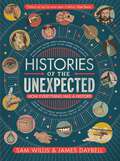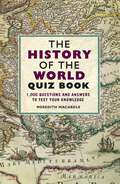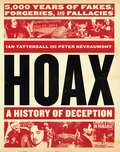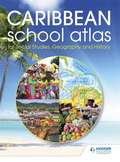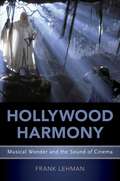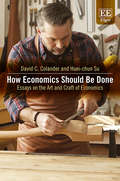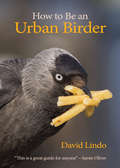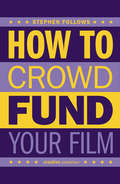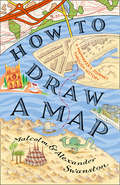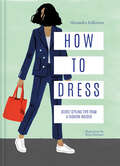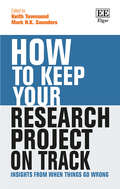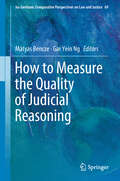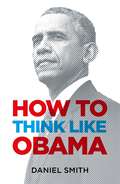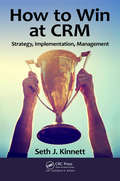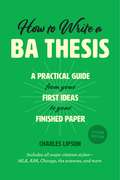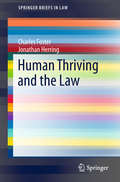- Table View
- List View
Histories of the Unexpected: How Everything Has a History (Histories Of The Unexpected Ser.)
by Dr Sam Willis Professor James Daybell'History as you've never seen it before.' Dan Snow'A wonderful, eclectic and entertaining history of everything, full of fascinating, surprising stories.' Suzannah LipscombDid you know that the history of the beard is connected to the Crimean War; that the history of paperclips is all about the Stasi; and that the history of bubbles is all about the French Revolution? And who knew that Heinrich Himmler, Tutankhamun and the history of needlework are linked to napalm and Victorian orphans?In Histories of the Unexpected, Sam Willis and James Daybell lead us on a journey of discovery that tackles some of the greatest historical themes - from the Tudors to the Second World War, from the Roman Empire to the Victorians - but via entirely unexpected subjects.By taking this revolutionary approach, they not only present a new way of thinking about the past, but also reveal the everyday world around us as never before.
The History of the World Quiz Book: 1,000 Questions and Answers to Test Your Knowledge
by Meredith MacArdleTaking the history of the world as its basis might seem a mammoth task but this fascinating book does just that, breaking the whole lot down into ten enthralling chapters that cover the ages and the world, from the Bronze Age up until the end of the Second World War.With over 5,500 years to choose from, and a whole world of events, you can be sure there is no shortage of intriguing history to explore. From the first empires and civilizations, through the Ancient world of the Middle East and Africa; the Parthian Empire; the Golden Age of India; the ancient dynasties of China; the founding of Rome and the Roman republic; Peruvian cultures; The Middle Ages; the Byzantine Empire; Mayan culture; the Crusades; the rise of the Ottoman Empire; the Renaissance – this far-reaching book will test the knowledge of any history lover and provide the ultimate challenge for even the most knowledgeable historian.With questions ranging through multiple choice, truth or fiction, maps and pictures, you will find there is always something new to learn about the world.
Hoax: 5,000 Years of Fakes, Forgeries, and Fallacies
by Ian Tattersall Peter NévraumontAn entertaining collection of the most audacious and underhanded deceptions in the history of mankind, from sacred relics to financial schemes to fake art, music, and identities. World history is littered with tall tales and those who have fallen for them. Ian Tattersall, a curator emeritus at the American Museum of Natural History, has teamed up with Peter Néaumont to tell this anti-history of the world, in which Michelangelo fakes a masterpiece; Arctic explorers seek an entrance into a hollow Earth; a Shakespeare tragedy is "rediscovered"; a financial scheme inspires Charles Ponzi; a spirit photographer snaps Abraham Lincoln's ghost; people can survive ingesting only air and sunshine; Edgar Allen Poe is the forefather of fake news; and the first human was not only British but played cricket. Told chronologically, HOAX begins with the first documented announcement of the end of the world in 2800 BC and winds its way through controversial tales such as the Loch Ness Monster and the Shroud of Turin, past proven fakes such as the Thomas Jefferson's ancient wine and the Davenport Tablets built by a lost race, and explores bald-faced lies in the worlds of art, science, literature, journalism, and finance.
Hodder Education Caribbean School Atlas (PDF)
by HodderFeel confident in full coverage of the curriculum requirements with an atlas specially created to cover Social Studies, Geography and History. - Encourage awareness of the whole Caribbean region with a 44-page Caribbean section, containing detailed maps of all independent countries and major dependent territories from The Bahamas to Trinidad, and including Belize and Guyana.- Engage students in topical issues with a world mapping section, including features on world climate, the environment and population. - Introduce a solid foundation in geographical knowledge with world facts and figures for all nations.- Secure strong geographical skills with a feature on map reading and how to use an atlas.- Ensure ease-of-use with a 4-page index showing letter-figure grid references to place names found on the maps.
HOLLYWOOD HARMONY OMMS C: Musical Wonder and the Sound of Cinema (Oxford Music/Media Series)
by Frank LehmanFilm music often tells us how to feel, but it also guides us how to hear. Filmgoing is an intensely musical experience, one in which the soundtrack structures our interpretations and steers our emotions. Hollywood Harmony explores the inner workings of film music, bringing together tools from music theory, musicology, and music psychology in this first ever book-length analytical study of this culturally central repertoire. Harmony, and especially chromaticism, is emblematic of the "film music sound," and it is often used to evoke that most cinematic of feelings-wonder. To help parse this familiar but complex musical style, Hollywood Harmony offers a first-of-its kind introduction to neo-Riemannian theory, a recently developed and versatile method of understanding music as a dynamic and transformational process, rather than a series of inert notes on a page. This application of neo-Riemannian theory to film music is perfect way in for curious newcomers, while also constituting significant scholarly contribution to the larger discipline of music theory. Author Frank Lehman draws from his extensive knowledge of cinematic history with case-studies that range from classics of Golden Age Hollywood to massive contemporary franchises to obscure cult-films. Special emphasis is placed on scores for major blockbusters such as Lord of the Rings, Star Wars, and Inception. With over a hundred meticulously transcribed music examples and more than two hundred individual movies discussed, Hollywood Harmony will fascinate any fan of film and music.
How Economics Should Be Done: Essays on the Art and Craft of Economics
by Huei-Chun Su David C. ColanderDavid Colander has been writing about economic methodology for over 30 years. His pragmatic approach sees applied policy methodology as rooted in what economists actually do, not in what methodologists say they should do. It sees applied policy methodology as constantly evolving as analytic and computational technology changes, evolving far too fast to be subject to any rigid scientific methodology. That problem is that economists generally think of applied policy analysis as applied science. Colander argues that using a scientific methodology to guide applied policy undermines good policy analysis. Instead, he contends that economists should use a much looser engineering methodology that blends science, heuristics, inescapable moral judgments, and creativity into what he calls the art and craft of economics. Here, Huei-chun Su has selected seventeen of Colander’s articles that spell out and capture his arguments at various levels – some formal academic articles dealing with cutting edge methodology, and some more popular articles making the case for his approach. An original introduction and annotated bibliography serve as excellent resources for further exploring his arguments. Clear, well-structured, and written in plain English with little jargon, the book is approachable and suitable for anyone interested in the current and future state of economics and the economics profession. This includes students at any level as well as methodologists, applied economists, historians and critics of modern economics.
How to Be an Urban Birder (WILDGuides #13)
by Jamie Oliver David LindoThe first guide to urban birding in the UK, from The Urban Birder himself, David LindoUrban birding is fast becoming ornithology’s new rock ’n’ roll. Birds and birding have never been cooler—and urban birding is at the cutting edge.How to Be an Urban Birder is the world’s first guide to the art of urban birding—which is so easy and great fun! Here, urban birding pioneer David Lindo tells you everything you need to know about birds and birding in towns and cities in the UK.Includes a brief history of urban birding in the UKCovers the best places to look for birds in towns and citiesHelps you get to know your urban birdsGives useful tips on how to attract birds to your gardenExplains what gear you need and how to go about being an urban birderFeatures hundreds of cool images and illustrations of birds in urban settings
How to Be an Urban Birder (WILDGuides #13)
by David Lindo Jamie OliverThe first guide to urban birding in the UK, from The Urban Birder himself, David LindoUrban birding is fast becoming ornithology’s new rock ’n’ roll. Birds and birding have never been cooler—and urban birding is at the cutting edge.How to Be an Urban Birder is the world’s first guide to the art of urban birding—which is so easy and great fun! Here, urban birding pioneer David Lindo tells you everything you need to know about birds and birding in towns and cities in the UK.Includes a brief history of urban birding in the UKCovers the best places to look for birds in towns and citiesHelps you get to know your urban birdsGives useful tips on how to attract birds to your gardenExplains what gear you need and how to go about being an urban birderFeatures hundreds of cool images and illustrations of birds in urban settings
How to Crowdfund Your Film: Tips and Strategies for Filmmakers
by Stephen FollowsCrowdfunding is a major source of funding for independent films and over $250 million has been raised for films just on Kickstarter alone. This book will guide you through every stage of planning, creating and running your film crowdfunding campaign.This book is based on extensive data research and interviews which include:Data research on over 50,000 film crowdfunding campaignsInterviews with over 50 filmmakers who have run crowdfunding campaignsInterviews with some of the top people at major crowdfunding platforms and servicesPraise for Stephen Follows'Stephen drills down on data to discover truths about the film industry. Totally worth a read' - Ted Hope, Head of Production, Amazon Original Movies'Stephen's research is brilliant. No-one is doing data-driven analysis of the film industry quite like Stephen Follows. His detailed research and reporting about the film industry is unique and invaluable' - Jonathan Wolf, Head of The American Film Market'Stephen is one of the most gifted producers I know. His mind operates at an entirely different speed to almost everyone I know, solving problems, offering solutions and innovating new opportunities at breakneck speed' - Chris Jones, author of The Guerrilla Filmmakers HandbookPlease note that this is a fixed-format ebook file.
How to Draw a Map
by Malcolm Swanston Alex SwanstonHow to Draw a Map is a fascinating meditation on the centuries-old art of map-making, from the first astronomical maps to the sophisticated GPS guides of today.
How to Dress: Secret Styling Tips From A Fashion Insider
by Alexandra FullertonThe perfect book for anyone who wants to know the secrets to always looking stylish with minimal effort.
How to Keep Your Research Project on Track: Insights from When Things Go Wrong
by Keith Townsend Mark N. K. SaundersTextbooks and journal articles on research methods are rarely of help regarding what to do when your research project goes off track. This book addresses this important, and usually hidden, aspect of research by providing students and researchers with insider insights, advice and lessons about the difficulties in the research process. Written by experienced researchers, PhD supervisors and examiners, it should prepare the reader for all that can go wrong when researching a PhD or any large research project. The starting point of each chapter is the acceptance that research projects do not always go smoothly. Researchers must find ways to jump through a myriad of invisible hoops and over a plethora of hurdles of unknown heights to guide their research, from conceptualisation of worthwhile projects to the completion and dissemination to a range of different audiences. The book is divided into four sections: ‘getting started’, ‘getting data’, ‘getting it together’, and ‘getting finished’. Each section comprises chapters followed by short vignettes – all of which offer insights into researchers facing real-world problems or not quite getting things right in the first instance. This ground breaking book will give hope to the early-career researcher, the PhD or Masters student, and provide experienced academics with reinvigoration and new perspectives on the research process.
How to Measure the Quality of Judicial Reasoning (Ius Gentium: Comparative Perspectives on Law and Justice #69)
by Mátyás Bencze Gar Yein NgThis edited volume examines the very essence of the function of judges, building upon developments in the quality of justice research throughout Europe. Distinguished authors address a gap in the literature by considering the standards that individual judgments should meet, presenting both academic and practical perspectives. Readers are invited to consider such questions as: What is expected from judicial reasoning? Is there a general concept of good quality with regard to judicial reasoning? Are there any attempts being made to measure the quality of judicial reasoning? The focus here is on judges meeting the highest standards possible in adjudication and how they may be held to account for the way they reason. The contributions examine theoretical questions surrounding the measurement of the quality of judicial reasoning, practices and legal systems across Europe, and judicial reasoning in various international courts. Six legal systems in Europe are featured: England and Wales, Finland, Italy, the Czech Republic, France and Hungary as well as three non-domestic levels of court jurisdictions, including the Court of Justice of the European Union (CJEU). The depth and breadth of subject matter presented in this volume ensure its relevance for many years to come. All those with an interest in benchmarking the quality of judicial reasoning, including judges themselves, academics, students and legal practitioners, can find something of value in this book.
How to Think Like Obama (How to Think Like ...)
by Daniel SmithBe inspired by Barack Obama and learn how to think big with this unique insight into the mind of one of the world’s great influencers. Born to a black Kenyan father and white American mother, raised in Hawaii and, for a time, Indonesia, Barack Obama would typically never have been tipped for a future president of the United States, such was the world he was born into. But the path towards greatness and the choices he made along the way can be understood by an attitude that saw him take on any challenge – indeed, ‘Yes We Can’ became the all-inclusive slogan for his presidential candidacy.Riding a wave of positivity and hope for the future that swept him all the way to the Oval Office, Obama aimed to define his presidency as one that would provide opportunities for the many, not the few. With the price of change being gritty negotiation and compromise, Obama evolved the skills of a twenty-first century president which belied his relative inexperience to achieve the America that, as a young man, he had dreamed of. How to Think Like Obama reveals the motivations, inspirations and philosophies behind a man who broke the mould to challenge the status quo. With his thoughts on leadership, innovation, overcoming obstacles and fighting inequality, and with quotes by and about him, with this book you too can learn to think like Barack Obama.
How to Win at CRM: Strategy, Implementation, Management
by Seth KinnettThis book provides clarity and guidance on effective strategy, implementation and management of CRM. It explores both the conceptual and cultural context of CRM initiatives along with the particulars of CRM system implementation and management. In order to provide this clarity, it surveyed the existing academic publications surrounding CRM, sales force automation, and related topics within information systems literature. The book supplements this research with insights from CRM experts to provide a robust picture of the CRM landscape and how to improve it no matter what role you play within your organization. This book is for everyone who wants to achieve CRM success.
How to Win at CRM: Strategy, Implementation, Management
by Seth KinnettThis book provides clarity and guidance on effective strategy, implementation and management of CRM. It explores both the conceptual and cultural context of CRM initiatives along with the particulars of CRM system implementation and management. In order to provide this clarity, it surveyed the existing academic publications surrounding CRM, sales force automation, and related topics within information systems literature. The book supplements this research with insights from CRM experts to provide a robust picture of the CRM landscape and how to improve it no matter what role you play within your organization. This book is for everyone who wants to achieve CRM success.
How to Write a BA Thesis, Second Edition: A Practical Guide from Your First Ideas to Your Finished Paper (Chicago Guides to Writing, Editing, and Publishing)
by Charles LipsonHow to Write a BA Thesis is the only book that directly addresses the needs of undergraduate students writing a major paper. This book offers step-by-step advice on how to move from early ideas to finished paper. It covers choosing a topic, selecting an advisor, writing a proposal, conducting research, developing an argument, writing and editing the thesis, and making through a defense. Lipson also acknowledges the challenges that arise when tackling such a project, and he offers advice for breaking through writer’s block and juggling school-life demands. This is a must-read for anyone writing a BA thesis, or for anyone who advises these students.
How to Write a BA Thesis, Second Edition: A Practical Guide from Your First Ideas to Your Finished Paper (Chicago Guides to Writing, Editing, and Publishing)
by Charles LipsonHow to Write a BA Thesis is the only book that directly addresses the needs of undergraduate students writing a major paper. This book offers step-by-step advice on how to move from early ideas to finished paper. It covers choosing a topic, selecting an advisor, writing a proposal, conducting research, developing an argument, writing and editing the thesis, and making through a defense. Lipson also acknowledges the challenges that arise when tackling such a project, and he offers advice for breaking through writer’s block and juggling school-life demands. This is a must-read for anyone writing a BA thesis, or for anyone who advises these students.
How to Write a BA Thesis, Second Edition: A Practical Guide from Your First Ideas to Your Finished Paper (Chicago Guides to Writing, Editing, and Publishing)
by Charles LipsonHow to Write a BA Thesis is the only book that directly addresses the needs of undergraduate students writing a major paper. This book offers step-by-step advice on how to move from early ideas to finished paper. It covers choosing a topic, selecting an advisor, writing a proposal, conducting research, developing an argument, writing and editing the thesis, and making through a defense. Lipson also acknowledges the challenges that arise when tackling such a project, and he offers advice for breaking through writer’s block and juggling school-life demands. This is a must-read for anyone writing a BA thesis, or for anyone who advises these students.
How to Write a BA Thesis, Second Edition: A Practical Guide from Your First Ideas to Your Finished Paper (Chicago Guides to Writing, Editing, and Publishing)
by Charles LipsonHow to Write a BA Thesis is the only book that directly addresses the needs of undergraduate students writing a major paper. This book offers step-by-step advice on how to move from early ideas to finished paper. It covers choosing a topic, selecting an advisor, writing a proposal, conducting research, developing an argument, writing and editing the thesis, and making through a defense. Lipson also acknowledges the challenges that arise when tackling such a project, and he offers advice for breaking through writer’s block and juggling school-life demands. This is a must-read for anyone writing a BA thesis, or for anyone who advises these students.
How to Write about Economics and Public Policy
by Katerina PetchkoHow to Write about Economics and Public Policy is designed to guide graduate students through conducting, and writing about, research on a wide range of topics in public policy and economics. This guidance is based upon the actual writing practices of professional researchers in these fields and it will appeal to practitioners and students in disciplinary areas such as international economics, macroeconomics, development economics, public finance, policy studies, policy analysis, and public administration. Supported by real examples from professional and student writers, the book helps students understand what is expected of writers in their field and guides them through choosing a topic for research to writing each section of the paper. This book would be equally effective as a classroom text or a self-study resource.Teaches students how to write about qualitative and quantitative research in public policy and economics in a way that is suitable for academic consumption and that can drive public policy debatesUses the genre-based approach to writing to teach discipline-appropriate ways of framing problems, designing studies, and writing and structuring contentIncludes authentic examples written by students and international researchers from various sub-disciplines of economics and public policyContains strategies and suggestions for textual analysis of research samples to give students an opportunity to practice key points explained in the bookIs based on a comprehensive analysis of a research corpus containing 400+ research articles in various areas of public policy and economics
Hugh Johnson's Pocket Wine Book 2019
by Hugh JohnsonHugh Johnson's Pocket Wine Book is the essential reference book for everyone who buys wine - in shops, restaurants, or on the internet. Now in its 42nd year of publication, it has no rival as the comprehensive, up-to-the-minute annual guide. Hugh Johnson provides clear succinct facts and commentary on the wines, growers and wine regions of the whole world. He reveals which vintages to buy, which to drink and which to cellar, which growers to look for and why. Hugh Johnson's Pocket Wine Book gives clear information on grape varieties, local specialities and how to match food with wines that will bring out the best in both. This new edition also contains a special supplement on Organic, Natural and Biodynamic wines.
Human Thriving and the Law (SpringerBriefs in Law)
by Charles Foster Jonathan HerringThe idea of the Good Life – of what constitutes human thriving, is, implicitly, the foundation and justification of the law. The law exists to hold societies together; to hold in tension the rights of individuals as against individuals, the rights of individuals as against various types of non-humans such as corporations (and vice versa), and the rights of individuals individuals as against the state (and vice versa). In democratic states, laws inhibit some freedoms in the name of greater, or more desirable freedoms. The only justification for law is surely that it tends to promote human thriving. But what is the Good Life? What does it mean to live a thriving life? There has been no want of discussion, at least since the great Athenians. But surprisingly, since human thriving is its sole raison d’etre, the law has been slow to contribute to the conversation. This book aims to start and facilitate this conversation. It aims to: -make lawyers ask: ‘What is the law for?’, and conclude that it is to maximise human thriving -make lawyers ask: ‘But what does human thriving mean?’ -make judges and advocates ask: ‘How can a judgment about the best interests of a patient be satisfactory unless its basis is made clear?’
Implementing Project and Program Benefit Management (Best Practices in Portfolio, Program, and Project Management)
by Kenn DolanOne of the most difficult, yet important, questions regarding projects is "What advantages will this project create for the investors and key stakeholders?" Projects and programs should be treated as investments. This means that the focus of projects shifts from delivering within the triple constraints (time–cost–quality) towards some of the more fundamental questions: What is the purpose of this investment? What are the specific advantages expected? Are these benefits worth the investment? Implementing Project and Program Benefit Management is written for executives and practitioners within the portfolio, program, and project environment. It guides them through the important work that must be addressed as the investment progresses towards the realization of benefits. The processes discussed cover the strategic elements of benefits realization as well as the more detailed requirements, which are the domain of the program delivery teams and the operational users. Using real cases to explain complex situations, operational teams and wider groups of stakeholders, including communities affected by infrastructure projects, will be able to engage in the conversation with the sponsors and delivery teams. Covering an area of program and project management that is rapidly becoming more widely valued, this book blends theory with practical experience to present a clear process flow to managing the benefits life cycle. Best practices are defined, and pitfalls and traps are identified to enable practitioners to apply rigor and structure to this crucial discipline.
Implementing Project and Program Benefit Management (Best Practices in Portfolio, Program, and Project Management)
by Kenn DolanOne of the most difficult, yet important, questions regarding projects is "What advantages will this project create for the investors and key stakeholders?" Projects and programs should be treated as investments. This means that the focus of projects shifts from delivering within the triple constraints (time–cost–quality) towards some of the more fundamental questions: What is the purpose of this investment? What are the specific advantages expected? Are these benefits worth the investment? Implementing Project and Program Benefit Management is written for executives and practitioners within the portfolio, program, and project environment. It guides them through the important work that must be addressed as the investment progresses towards the realization of benefits. The processes discussed cover the strategic elements of benefits realization as well as the more detailed requirements, which are the domain of the program delivery teams and the operational users. Using real cases to explain complex situations, operational teams and wider groups of stakeholders, including communities affected by infrastructure projects, will be able to engage in the conversation with the sponsors and delivery teams. Covering an area of program and project management that is rapidly becoming more widely valued, this book blends theory with practical experience to present a clear process flow to managing the benefits life cycle. Best practices are defined, and pitfalls and traps are identified to enable practitioners to apply rigor and structure to this crucial discipline.
